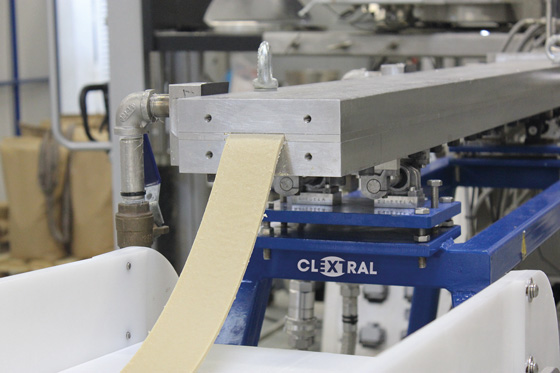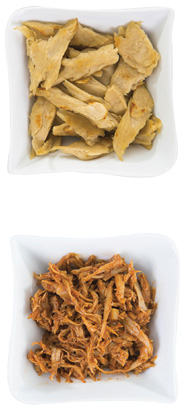How Plant-Based Meat and Seafood Are Processed
PROCESSING

This month’s Processing column continues the theme of “How is it processed?” with a focus on plant-based meat and seafood. A brief overview of the history and market for plant-based meats and seafood will be reviewed. Processing technologies and ingredients used to produce these products will be described.
I wish to thank my co-author, Roberto Avena-Bustillos, research food technologist at the U.S. Department of Agriculture, Agricultural Research Service, for contributing to this column.
As more consumers gravitate toward vegetarian diets and become aware of the overexploitation of natural resources resulting from a rapidly increasing global population, more meat and seafood alternatives made from plant proteins have been developed in recent years.
MarketsandMarkets estimates that the plant-based meat market is currently valued at $12.1 billion and expected to reach a value of $27.9 billion by 2025. Extrusion cooking, shear cell, and other technologies are used to process these products. Extrusion and shear cell processing will be reviewed in this column and examples of commercial plant-based meat and seafood products will be presented.
Extrusion Technology
High-moisture extrusion processing can be used to create plant-based meat and seafood textures. During extrusion, proteins undergo thermal and mechanical stresses by heating of the barrel and shearing of the screws. As a result, protein structure is altered leading to the formation of soluble and/or insoluble aggregates. By attaching a long cooling die to the end of the extruder (as shown in the photograph on this page), proteins can be aligned in the flow direction forming an anisotropic protein network.
A wide range of final product characteristics can be achieved by altering process conditions during high-moisture extrusion processing. Process conditions in the screw section can be varied through independent process parameters, such as barrel temperature, screw speed, and configuration, whereas process conditions in the die section can be varied through cooling rate and die geometry. This improves the flexibility of the process to a significant extent. Extrusion is a multivariate complex process, and the sections are directly linked to each other. Any change in one section (e.g., cooling rate in die section) results in a change in process conditions in the other section (e.g., pressure and filling degree in screw section).
Several studies have been able to provide a better understanding of the effect of temperature and/or moisture content on molecular structure and physicochemical and final product properties for soy and pea proteins. Furthermore, thermal as well as mechanical treatment during extrusion processing affect proteins’ molecular structure and product properties during extrusion processing.
Recently, wet texturization has emerged using twin-screw extrusion in a combination of a series of chemical and physical processes (thermomechanical cooking and die fibration) to produce a more fibrous structure and meat-like texture of the resulting products. Appropriate pretreatment allows the use of a larger spectrum of proteins and other ingredients such as starches, fibers, and additives. By employing an additional processing step, the extruded mass is subjected to further treatment using forming units (additional plasticizing devices), where it is chilled, unified, textured, and/or molded into strips, patties, or other forms. High-moisture texturized proteins are usually processed and packaged in wet condition (pouches, cans, or frozen).
Shear Cell Technology
 High-temperature and shear-induced structure formation of protein mixtures can also be achieved using a high-temperature conical shear cell. Wageningen University developed a larger-scale Couette shear device based on the concentric cylinder rheometer concept. The sample material is placed in the shearing zone space between the two cylinders; this space has a volume of ~7 L and a 30 mm distance between the two cylinders. Both the inner and outer cylinders are heated by means of steam and cooled by means of air and/or water. The advantages of this new technology are the production of larger pieces of fibrous meat analogues with a simple, mild, and cost-effective technology.
High-temperature and shear-induced structure formation of protein mixtures can also be achieved using a high-temperature conical shear cell. Wageningen University developed a larger-scale Couette shear device based on the concentric cylinder rheometer concept. The sample material is placed in the shearing zone space between the two cylinders; this space has a volume of ~7 L and a 30 mm distance between the two cylinders. Both the inner and outer cylinders are heated by means of steam and cooled by means of air and/or water. The advantages of this new technology are the production of larger pieces of fibrous meat analogues with a simple, mild, and cost-effective technology.
Commercial Products
The following are examples of plant-based meat and seafood products that can currently be found in the marketplace. This list is not all inclusive.
Beyond Meat produced the world’s first plant-based burger, beef, sausage, and beef crumbles under the brand Beyond using five main ingredients: pea protein isolate, canola and coconut oils, trace minerals, carbohydrates, and water, which is included in the beet juice to simulate the red color of beef.
Impossible Foods produces the Impossible Burger using soy protein concentrate, soy protein isolate, and potato protein, as well as coconut and sunflower oils, natural flavors, and several hydrocolloids, minerals, and vitamins. Relevantly, it also contains soy leghemoglobin, a heme-containing protein from the roots of soy plants.
Soy and wheat-based proteins are used in the Awesome Burger and Incredible Burger from Nestlé and sold in refrigerated and frozen sections at retailers across Europe.
Kraft Foods produces plant-based protein BOCA meatless patties (beef, turkey, chicken flavors), skillet meals, bowls, falafels, crumbles, and chicken nuggets using soy protein concentrate, isolated soy protein, and hydrolyzed soy protein as main plant-based protein ingredients.
Good Catch Foods addresses the few options for plant-based seafood products in the market by producing tuna analogues with a proprietary blend of five legume proteins (lentil, navy bean, peas, chickpea, soy, and fava beans) to deliver tuna products with similar sensory attributes in terms of texture, flavor, and nutritional profile (low in fat, high in protein, and omega oils) as real tuna.
New Wave Foods produces a plant-based shrimp alternative made from seaweed, soy protein, and natural flavors and other natural ingredients that offer briny, lightly savory, and subtly sweet notes that taste like shrimp.
No Evil Foods uses wheat gluten, red kidney beans, and chickpea flour as sources of plant-based proteins to produce chicken, sausages, chorizo, and pulled pork barbecue analogues.
Monde Nissin Corp. is marketing a range of meat-free protein products under the Quorn brand. This brand includes ingredient-type products to cook from scratch like fillets or grounds and ready-to-cook options like nuggets and burgers. Its main ingredient is a mycoprotein, a naturally healthy protein low in saturated fat and calories, high in fiber and protein, and with zero cholesterol.
Ingredients for Plant-Based Meats and Seafood
In a world where soy has long been the plant-based protein of choice for many vegetarian and vegan dishes and food products, there are other new options for plant-based protein sources, such as the following.
Pulses. Pulse flours derive from yellow and green peas, lentils, chickpea, fava, and mung beans with 55% to 60% protein concentrations. The natural flavor profile of pulse is beany, but clean-taste pulse ingredients for easy integration for meat analogue applications are becoming available.
Root Vegetables, Cereals, and Oilseed Proteins. New sources of plant-based proteins making inroads in plant-based meat analogue development are leafy vegetables, such as broccoli; root vegetables, such as carrot and potato; oil seeds, such as pumpkin seed, sunflower seed, watermelon seed, almond, and coconut proteins; and grains, such as ancient grains and corn proteins.
Seaweed and Algae. The nutritional density and seafood flavor resemblance of seaweed, algae, and microalgae support their application in seafood analogues. Protein content in seaweed ranges from as low as 3% to as high as 50%, while the protein content of microalgae found in marine and fresh water, is much higher, up to 70%, making them a viable source of protein.
Lenteins. Also known as water lentils, lenteins have an excellent amino acid profile compared with soy protein. Derived from the Lemnoideae plant, lenteins can double in biomass every day. A company called Parabel is currently producing high volumes of these nonallergenic leaf proteins.
Hemp. Hemp protein powders have a nutty flavor, white color, and a smooth mouthfeel with high solubility. Hemp is an eco-friendly, nutrition-rich plant protein whose sustainability and adaptability make it a viable new ingredient option for plant-based meat analogues.
Mycoproteins. Mycoprotein derived from the Fusarium venenatum fungus has been used for several years as a meat substitute. Shitakes and other mushrooms are considered the next generation of plant-based proteins. Mycoprotein is highly digestible and bioavailable and has a meaty flavor with a slight savory umami taste and meat-like texture.
A Look Ahead
The actual trend toward flexitarian, vegan, and vegetarian diets is influencing the use of plant-based proteins as meat and seafood substitutes. While most meat substitutes still are based on soy or wheat gluten protein, new meat analogues are emerging as well with alternative proteins, binders, flavor enhancers, and natural colors. New research and development will need to answer and solve the interactions of flavors and colorants with plant-based proteins and how water binds with plant-based proteins to allow an increase of juiciness and freshness of new plant-based protein meat and seafood analogues.
Tara McHugh, PhD, Contributing Editor
• Research Leader, USDA Agricultural Research Service, Albany, Calif.
• [email protected]
Roberto Avena-Bustillos is a Research Food Technologist at the U.S. Department of Agriculture, Agricultural Research Service ([email protected]).
REFERENCES
Krintiras, G.A., J. Gadea Diaz, A. J. van der Goot, et al. 2016. “On the use of the Couette Cell technology for large scale production of textured soy-based meat replacers.” Journal of Food Engineering 169: 205–213.
Lechevin, A. S., L. Tobo, and S. Hood-Niefier. 2019. The Ultimate Meat Substitutes Guide. CLEXTRAL, Firminy, France.
Pietsch, V. L., M. A. Emin, and H. P. Schuchmann. 2017. “Process conditions influencing wheat gluten polymerization during high moisture extrusion of meat analog products.” Journal of Food Engineering 198: 28–35.
Schreudersa, F. K. G., B. L. Dekkersa, I. Bodnárb, et al. 2019. “Comparing structuring potential of pea and soy protein with gluten for meat analogue preparation.” Journal of Food Engineering 261: 32–39.


